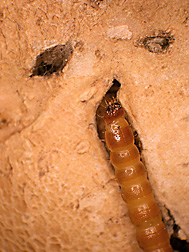This page has been archived and is being provided for reference purposes only. The page is no longer being updated, and therefore, links on the page may be invalid.
| Read the magazine story to find out more. |
|
|
|
|
Scientists Develop New Potato Lines to Wage War on Wireworms
By Jan SuszkiwSeptember 19, 2011
When wireworms feast on potatoes, the results aren't pretty: The spuds' surfaces are left punctured, pitted and unappealing. For the past few years, U.S. Department of Agriculture (USDA) scientists and their colleagues have sought a solution in the form of spuds with genetic resistance to the worms, with special attention focused on two wild potatoes from Chile and Bolivia: Solanum berthaultii and S. etuberosum.
Previous studies showed that the wild potatoes resisted Colorado potato beetles and green peach aphids, two very different pests. Given this broadspread resistance, the researchers decided to see how the spuds fared against wireworms, which are the click beetle's larval stage.
To do this, the researchers crossed germplasm derived from the wild potatoes with a cultivated variety, and then selected 15 top-performing plants from three generations of progeny. Their next step was to plant the progeny lines, called "breeding clones," in wireworm-infested field plots and compare the damage they sustained with that seen in flanking rows of Russet Burbank potatoes—some treated with insecticide and some that hadn't been treated.
The results showed that the resistant clones fared just as well, and in some cases better than, the insecticide-treated Russet Burbank potatoes. The research has been accepted for publication in the Journal of Economic Entomology.
Growers now use organophosphate- and carbamate-based insecticides against wireworms, notes Rich Novy, a plant geneticist with the Agricultural Research Service (ARS) Small Grains and Potato Germplasm Research Unit in Aberdeen, Idaho. However, the continued registration of some of these insecticides is uncertain. Also, the chemicals don't always eliminate the slender, brownish-orange pests, which can survive beneath the soil for as long as five years before emerging as adults.
The researchers suspect natural compounds called glycoalkaloids may be protecting the breeding clones. Fortunately, the total glycoalkaloid concentrations in many of the resistant clones are well below levels deemed harmful to consumers.
Read more about this research in the September 2011 issue of Agricultural Research magazine.
ARS is USDA's principal intramural scientific research agency, and the research supports the USDA priority of promoting international food security.

